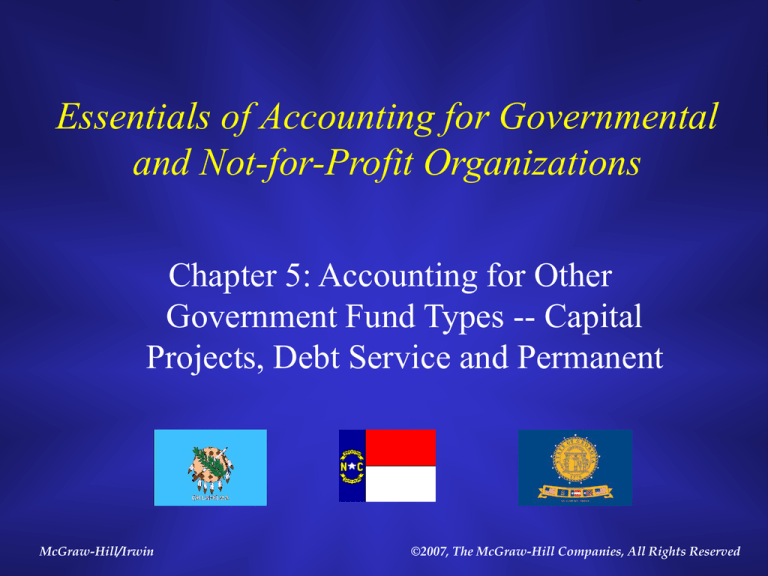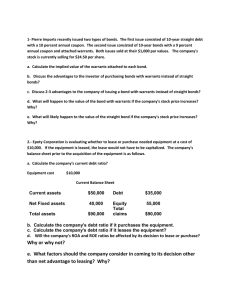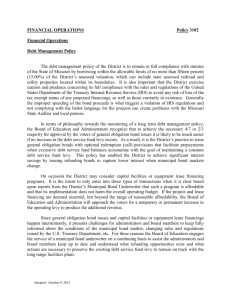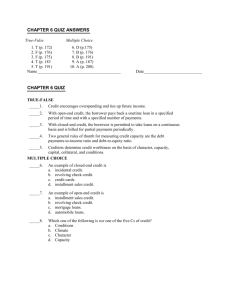
Essentials of Accounting for Governmental
and Not-for-Profit Organizations
Chapter 5: Accounting for Other
Government Fund Types -- Capital
Projects, Debt Service and Permanent
McGraw-Hill/Irwin
©2007, The McGraw-Hill Companies, All Rights Reserved
5-2
Overview of Chapter 5
• Review of common characteristics of
governmental type funds
• Capital Projects Funds
• Debt Service Funds
• Permanent Fund
• Review of Fund statements—Government
type funds
5-3
Review of Governmental Type
Funds
• Use modified accrual basis
– Long-term asset purchases are treated as
expenditures, no depreciation
• Generally do not carry long-term assets or longterm liabilities on fund balance sheet
• If annual budget is used, may be recorded in fund
• If control of purchase orders is relevant to the
fund, can use encumbrance accounting
5-4
Capital Project Funds
• Used for construction or acquisition of major longterm assets such as buildings, bridges, etc. for
government funds
– Proprietary type funds handle construction activities in
proprietary fund, not capital project fund
• Accounts for issuance of bonds and receipt of other
financing sources
• Accounts for construction or acquisition expenditures
• Does not carry the long-term asset in the CP fund—
Treated as expenditure in the fund
– Long-term asset is listed in entity-wide Statement of Net
Assets
5-5
Primary Sources of Funds for
Capital Projects
•
•
•
•
•
Issuance of bonds
Grants from other government units
Transfers from other funds
Donations
Interest earned on funds held
5-6
Bond Issues
• Long-term bonds are not fund liabilities in
governmental type funds
– If $12,000,000 of bonds are issued you would record
Cash
$12,000,000
Other financing sources: Bond Proceeds
$12,000,000
• Bond proceeds are considered an Other Financing
Source on the Statement of Revenues, Expenditures
and Changes in Fund Balance
– Bond proceeds is not a revenue per se, but is considered an
current inflow on the activity statement
5-7
Number of CP Funds to Use
• Some jurisdictions may require separate CP for
each building project
• Otherwise, may account for all, or at least related
construction projects, in a single fund using the
‘fund within a fund’ approach
– Separate accounts for:
• Expenditures - Project 1,
• Expenditures - Project 2, etc.
• General rule—make sure you can prove funds
intended to be used on a specific project are
traceable to the project
5-8
Lease Accounting for state and
local governments
• Operating leases—true rental situation
• Capital leases—these are ‘in-substance’ purchases of long-term
assets on time with interest
• Criteria to be treated as capital lease are same as for businesses
o Transfers ownership
o Contains bargain purchase option
o Life greater than 75% of asset’s life
o Present value of minimum lease payments greater than 90%
of fair value of asset
5-9
Lease Issues Cont’d
• At the inception (beginning) of the lease, the
present value is recorded as follows:
Expenditure Dr = PV of payments
Other Fin. Source – Lease Cr = PV of payments
– The Expenditure reports the equivalent of an
asset purchase, and the OFS credit shows the
equivalent of issuing a long-term note
5-10
Capital Leases in
Government Funds
• A 20-year lease of a building would be considered
equivalent to a purchase of the building and payment
of a long-term note
• In Government type funds using modified accrual
– Building purchases are expenditures
– Long-term note proceeds are Other Financing Sources
• Therefore, the full present value of the building would be
treated as an Expenditure when the lease is signed and the full
present value of the note would be treated as an Other
Financing Source
5-11
Lease Issues Cont’d
• At the inception of the lease the present value of
lease payments is recorded as the value of the
asset and of the liability in the entity-wide
statements
– Over time, the net asset value in the entity wide stmt of
net assets is decreased by its accumulated depreciation
– Over time, the liability is decreased by the amount of
the principal portion included in each lease payment
5-12
Special Assessments
• “Special” Assessments are similar to
property tax payments, but the payer
receives direct benefits
• Citizens in a limited area may vote or
petition the government to provide and
charge them for these benefits
5-13
Special Assessment Types
• Service type:
– Example, down town merchants want enhanced police
protection and are willing to pay for it through extra
assessments
• Construction type:
– Example, residents want their street paved and are
willing to have the cost charged to them over a period
of time
5-14
Accounting for Service Assessments
• The state and local government will use
whatever fund they normally use for that
service to record the assessment revenue
– For example, if the assessment is for extra policing
and police costs are in the general fund, then the
assessments will be treated as general fund revenues
– If the assessment were for service normally accounted
for in a special revenue or enterprise fund, then use
those funds
5-15
Accounting for Construction Assessments
• Accounting is different for the following two
scenarios:
– The government unit is primarily or secondarily liable
to pay off the special assessment construction loan in
the event that taxpayer revenues are insufficient
– The government will NOT hold itself liable, either
legally or by choice, in the event that taxpayer
payments are insufficient to pay the debt
5-16
Construction Special
Assessment Issues
• Government liable on the debt
– Record construction in CP fund as usual
– Record repayment of debt in DS fund as usual
– List assets constructed and the special
assessment debt in the entity-wide statement of
Net Assets
– The effect is to treat the debt and related project
as if it were undertaken by the government
5-17
Construction Special Assessment Issues
Cont’d
• Government not liable on debt
– Debt/bonds not listed in entity wide stmt of Net
Assets since it not an obligation of the
government
– Collections of assessments from taxpayers and
remittance to bondholders are handled in an
agency fund
5-18
Purpose of Debt Service Fund
• The debt service fund accumulates resources to pay debt
principal and interest on long-term debts of the overall
government
– DS fund is not used for proprietary fund debts, those funds carry their
own long-term debt
• While the debt service accumulates money and makes principal
and interest payments, bonds payable is not a liability of the DS
fund because the DSF uses the modified accrual basis/flow of
current resources approach
• The Bond Liability is in the entity-wide statement of Net Assets
5-19
Sources of DS Financing
• Taxes or special assessments earmarked
for debt service
• Transfers from the General fund
• Premiums or accrued interest on bond
issuance are often transfer to DSF from
Capital Project fund (CPF)
• Refinancing bond proceeds
• Residual equity transferred from CPF
5-20
Modified Accrual Basis & DSF
• Exception to expenditure portion of modified accrual
definition
– Most expenditures are recorded when the liability is incurred
– EXCEPT for interest and principal which is record in the DSF as an
expenditure when DUE
• But, there is an exception to the exception:
– Example: When year ends December 31, 20X1 bond payments
is due January 1, 20X2 ( or within a month), and the money for
the payment was provided in the 20X1 budget—then an
expenditure and liability for the upcoming payment may be
recorded in fiscal year 20X1
– Key issue—put expenditure in the year it was budgeted
5-21
Uses of Debt Service Funds
• Sinking fund and payments on term
bonds
• May use them for serial bond payments,
or can be handled in general fund
• Payments on long-term notes
• Payments on capital lease (but could be in
GF)
5-22
Types of Debt
• For serial bonds, money is moved in, payments
made, and little or no balance exists at year end
– Because of this simplicity, some governments may
actually handle Debt service in General Fund if
allowed by law
• Term bonds: All the principal of the bond comes due
at end of the term (perhaps after 30 years), interest
may be paid over time, or all at the end as well
• Deferred serial bonds: these may not start the
payments for 2 to 5 years after the bonds are used
– Allows time for property taxes to begin coming in
before payments start
5-23
Types of Debt cont’d
• In term bond and deferred serial bond
situations, the DSF acts as a sinking fund:
– Money is moved into the fund and invested in
revenue generating investments
– Present value techniques and amortization
tables are used to plan the amount of money
that must be invested so that original money
plus revenue earned over time equals required
bond principal and interest payments
5-24
DSF and Lease Payments
• Debt Service Funds are commonly used for
capital lease payments, though General
Fund may sometimes be used
• In DSFs both the payment of principal and
payment of interest result in an
EXPENDITURE
– However, should keep the amounts
separate,
– Because only the principal portion reduces
the net liability on the entity wide
Statement of Net Assets
5-25
Permanent Funds
• Permanent fund characteristics:
– A principal amount which is to be invested
in perpetuity
– Earnings in the fund can be spent for
purposes that benefit the government or its
citizens
• Example: Perpetual cemetery fund set up
by citizen donation
5-26
Review of Fund Financial
Statements for Government
Type Funds
• Balance Sheet for all Government funds
– Must list General Fund, Major Funds, and a
single column for nonmajor funds
– Okay to show nonmajor funds separately if
does not make the reports too cumbersome
– Note: Fund Balance shows Reserved and
Unreserved
5-27
Review Cont’d
• Statement of Revenues, Expenditures, and Changes
in Fund Balance Will have columns for the same GF,
Major, and Nonmajor funds used in Balance Sheet
• Format:
–
–
–
–
–
Revenues - Expenditures
+ or - Other Finance Sources/Uses
+ or - Special Items
= Change in Fund Balance
+ Beginning Bal = Ending Fund Balance
• Note Character Classifications of Expenditures—
Current, Debt Service, Capital Outlay








